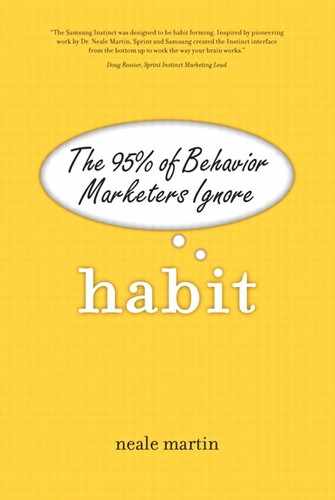Discovery
To form a habit, customers must repeat three sets of behaviors: discovery, purchase, and use.
Discovery involves all the steps that a noncustomer goes through before making a purchase. How do customers find out about products in a given category? Does advertising affect them? If so, which media? Do they go to web sites? If so, which ones? Do they rely on friends or trusted sources? Do customers need to see or touch the product to buy it?
Properly positioning a brand into this discovery process is an important first step. Working with prospective customers’ existing search habits is a much more efficient use of advertising dollars. Also, matching the target market’s method of discovery helps the category neurons in the PFC position the brand appropriately. Companies often work against the mental habits of the unconscious mind and need to ratchet up the volume just to get noticed.
For example, in business-to-business (B2B) sales, small to medium-sized companies often rely on a trusted influencer such as a consultant or value-add reseller. Attempting to bypass this influencer with ads or sales calls will not be effective. You must sell the influencer before you have a chance with the decision maker.
Similarly, it is important to understand how different segments explore information. Although Walt Mossberg of the Wall Street Journal might heavily influence people over the age of 40, younger demographics might look for information on the same product by going to the irreverent video podcasts of Kevin Rose and Alex Albrecht of DiggNation.
The shift in advertising to the Internet is a good example of how changing habits create new threats and opportunities. Google’s business model taps into the thousands of small businesses that cannot afford traditional advertising but can instead use AdWords to reach their limited audience. But Google understands that habitual behavior is linked to reinforcement, so ads are rank-ordered on a quality score (based on click-through and relevance) and the bid price.
The Internet has also become a favored marketing vehicle for Hollywood. Setting up a web site and having fans download trailers is much cheaper than buying airtime on television. The movie trailer is its own art form, but long gone are the days when a trailer alone gets us to the theater. Movie reviews are just a click away, and producers who opt not to prescreen movies for critics are assumed to be marketing a bomb. The review megasite Metacritic.com flags movies that have not been reviewed, offering a clear warning to users to enter at their own risk.
The next component of the front end of building habits is to communicate on a salient issue that is critical to the executive mind. At the early phases of the purchase process, the brand must appeal to a key issue that customers in this segment have identified as critical to purchase. This might be an issue of perception of need, levels of quality, reliability, price, or some other variable. If the message does not resonate on a critical factor, customers probably will not notice, but, even if they do, it won’t lead to habituation.
For example, if price is not a critical factor in a product category, but a company heavily promotes its price advantage, the company might get a sale. However, unless the trial usage reveals a connection on a more important issue, it will not lead to the type of repeat purchase behavior necessary for habit formation. A dry cleaner might offer a special on shirts and blouses, which causes you to try them out. But if the location is not convenient, you won’t use it habitually.
Prepurchase advertising needs to spark a behavior. Karen Pryor’s observation that a behavior must occur before it can be reinforced is critical for marketers to understand. During training sessions, animals and students voluntarily offer behavior looking for reinforcement. Ads should facilitate trial behavior by getting customers to look for a product in the store, and also by getting them to look for the product in the real world. An ad that could get a potential customer to say “Hey, can I look at that?” to a friend or colleague advances the purchase process all the way to trial.
Conversely, advertising can make social discourse less likely. The level of negativity in political advertising makes it difficult to actually talk politics anymore. The major political parties have crafted wedge issues that turn policy differences into moral Armageddon. Politicians should remember that voters make two judgments on a candidate—one with the executive brain and one with the emotional brain. They vote based on emotion.
If your reaction to this is “And that’s what’s wrong with the country,” you are missing a central component of habit formation. Although emotions can be manipulated, they are central to making good decisions. If you sense that a politician is dishonest, that information is probably more important than whether you agree with his or her public stance on immigration. The problem is that negative emotions such as fear are more likely to spur you to vote than positive emotions. Although you might logically weigh the issues, the cue that gets you to the ballot box will likely bypass your executive brain altogether.
